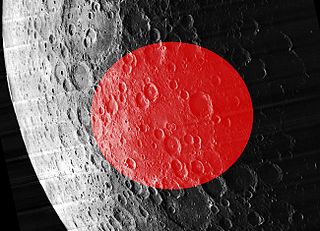
Abul Wafa is an impact crater located near the lunar equator on the far side of the Moon, named after the Persian mathematician and astronomer Abu al-Wafa' Buzjani. To the east are the crater pair Ctesibius and Heron. In the northeast lies the larger crater King, and to the southwest is Vesalius.

Anders is a worn lunar impact crater that is located in the southern hemisphere on the far side of the Moon. It lies just to the southeast of the outer rim of the huge walled basin named Apollo. To the south-southeast is the crater Leavitt.

Asclepi is a heavily eroded lunar impact crater that lies in the rugged southern highlands of the Moon. The outer rim has been worn down and rounded by many millions of years of subsequent impacts, so that it is now nearly level with the surrounding terrain. As a result, the crater is now little more than a depression in the surface. The interior is nearly flat and relatively featureless.

Fizeau is a prominent lunar impact crater that is located on the far side of the Moon, in the southern hemisphere. Nearby craters of note include Minkowski to the west-northwest, and Eijkman to the southwest.

Barringer is a lunar impact crater that is located on the southern hemisphere on the far side of the Moon. It is attached to the north-northeastern rim of the walled basin named Apollo, and lies to the southeast of Plummer. South of Barringer, on the floor of the Apollo basin, is the crater Scobee.

Blackett is a lunar impact crater that lies on the far side of the Moon, behind the southwest limb. It lies beyond the southeast outer ring of the immense Mare Orientale basin. The formation of that major feature has left Blackett deeply marked with ridge features trending from the northwest. Much of the crater has been shaped by the ejecta from Mare Orientale, particularly along the western half of the crater.

Birkeland is a lunar impact crater that lies in the southern hemisphere on the far side of the Moon. This crater is attached to the central waist of the oddly shaped Van de Graaff crater formation, and may partly account for that crater's figure-8 shape. To the southeast is the large walled plain Leibnitz.
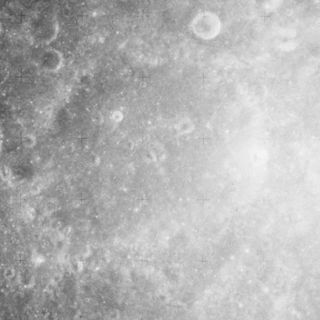
Buisson is a lunar impact crater that is located on the far side of the Moon. It is named after the French physicist Henri Buisson. Nearly attached to the southeast rim is the crater Vesalius. To the southwest is Einthoven. The rim of this crater is somewhat worn, and is lowest in the north. There is a low central ridge across the midpoint.
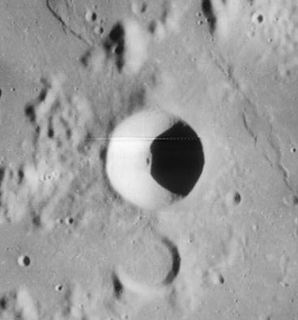
Darney is a small lunar impact crater that is located on the region of the Moon where the Mare Nubium joins the Oceanus Procellarum. It was named after French astronomer Maurice Darney. To the south is the lava-flooded crater Lubiniezky. The southern rim of Darney is attached to a series of low ridges that extend to the southwest.
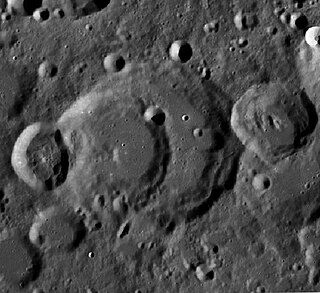
Perrine is a lunar impact crater that is located on the northern hemisphere on the far side of the Moon. It lies to the west of the large walled plain Landau, and to the northeast of the crater Charlier. To the north-northwest is the smaller Gullstrand.

Chebyshev is a large lunar impact crater that lies in the southern hemisphere on the far side of the Moon. The somewhat smaller crater Langmuir is intruding into the east-southeastern rim of Chebyshev, forming a chain of large craters with Brouwer on Langmuir's eastern rim.

Faye is a heavily eroded lunar impact crater in the rugged southern highlands of the Moon. It is named after French astronomer Hervé Faye. It is attached to the northeastern rim of the crater Delaunay, with Donati located just a few kilometers to the northeast. It forms part of a chain of craters of increasing size to the southwest that continues with La Caille and ends with the walled plain Purbach.
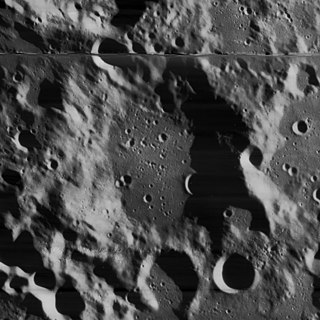
Wilson is a lunar impact crater that lies in the southern part of the Moon's near side, to the southwest of the large walled plain Clavius. It is nearly attached to the southeastern rim of the slightly larger crater Kircher. Almost due east lies Klaproth, another walled plain.

Denning is a lunar impact crater that is located on the far side of the Moon. It lies about midway between the craters Levi-Civita to the south and Marconi to the north-northeast. About two crater diameters to the southeast is the huge walled plain Gagarin.

Evershed is a lunar impact crater on the far side of the Moon, named after the English solar astronomer John Evershed. It is located to the northeast of the larger crater Cockcroft, and to the north of the smaller Van den Bergh.
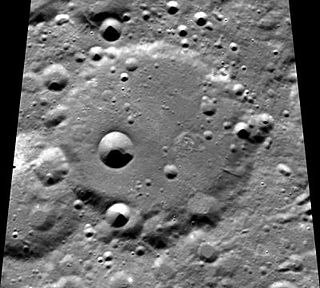
Mezentsev is a lunar impact crater that is located in the high northern latitudes on the Moon's far side. It lies just to the west of the smaller Niepce. To the southwest is the larger Stebbins, to the west-southwest is Hippocrates and to the northwest is Heymans.

Orlov is a lunar impact crater. It is located on the Moon's far side, to the northeast of the larger crater Leeuwenhoek. To the north-northwest of Orlov is De Vries, and to the east-southeast is Rumford.
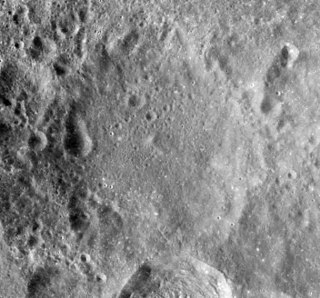
Perepelkin is a lunar impact crater that is located just to the south of the similar crater Love. It was named after Soviet astrophysicist Yevgeny Perepyolkin. Attached to the exterior of its southern rim is the smaller Shirakatsi. Less than one crater diameter to the east-northeast is Lane, and to the west-southwest are the co-joined Danjon and D'Arsonval.
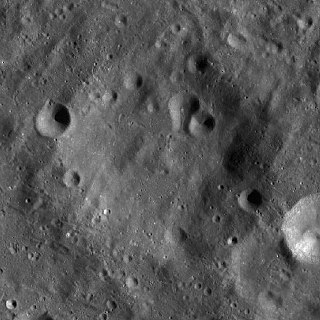
Wan-Hoo is a lunar impact crater that is located on the Moon's far side, and it cannot be seen directly from the Earth. It lies to the southwest of the huge walled plain Hertzsprung, within the outer skirt of ejecta. Just to the south-southwest of Wan-Hoo is the larger crater Paschen, and a little over two crater diameters to the northwest is Sechenov.

White is a lunar impact crater. It lies on the far side of the Moon from the Earth, to the southwest of the huge walled plain Apollo. About one crater diameter to the south-southwest is the small crater Hendrix.






